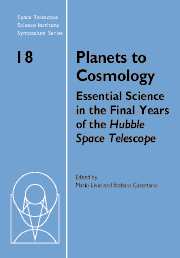 Planets to Cosmology
Planets to Cosmology Book contents
- Frontmatter
- Contents
- Participants
- Preface
- Hubble's view of transiting planets
- Unsolved problems in star formation
- Star formation in clusters
- HST abundance studies of low metallicity stars
- Physical conditions and feedback: HST studies of intense star-forming environments
- Quasar hosts: Growing up with monstrous middles
- Reverberation mapping of active galactic nuclei
- Feedback at high redshift
- The baryon content of the local intergalactic medium
- Hot baryons in supercluster filaments
- Galaxy assembly
- Probing the reionization history of the Universe
- Studying distant infrared-luminous galaxies with Spitzer and Hubble
- Galaxies at z ≈ 6–i′-drop selection and the GLARE Project
- The Hubble Ultra Deep Field with NICMOS
The Hubble Ultra Deep Field with NICMOS
Published online by Cambridge University Press: 17 August 2009
- Frontmatter
- Contents
- Participants
- Preface
- Hubble's view of transiting planets
- Unsolved problems in star formation
- Star formation in clusters
- HST abundance studies of low metallicity stars
- Physical conditions and feedback: HST studies of intense star-forming environments
- Quasar hosts: Growing up with monstrous middles
- Reverberation mapping of active galactic nuclei
- Feedback at high redshift
- The baryon content of the local intergalactic medium
- Hot baryons in supercluster filaments
- Galaxy assembly
- Probing the reionization history of the Universe
- Studying distant infrared-luminous galaxies with Spitzer and Hubble
- Galaxies at z ≈ 6–i′-drop selection and the GLARE Project
- The Hubble Ultra Deep Field with NICMOS
Summary
The Advanced Camera for Surveys (ACS) observations of the Hubble Ultra Deep Field (HUDF) provide the highest sensitivity optical observations of galaxies and stars ever achieved. The Near Infrared Camera and Multi-Object Spectrometer (NICMOS) observations in the central portion of the field extend the wavelength coverage by a factor of two to beyond 1.6 microns. Although not as sensitive as the ACS images due to a much smaller field and less observing time, the NICMOS observations extend the redshift range of the HUDF to redshifts as high as 13. Even though the observations are sensitive to redshift 13 objects, we confine our investigation to objects between redshifts of 7 and 9 where there is flux in both the F110W and F160W bands. Candidate sources in this redshift region are identified by requiring a non-detection in the ACS bands and a detection in both the F110W and F160W bands. All of the candidates have an almost flat or blue color in the F110W and F160W bands. The extremely high sensitivity of the ACS observations make this a very stringent criterion. We identify five candidates for objects in this redshift range and discuss tests of the reality of these sources. Although the sources are selected to have flux in both NICMOS bands and none in the ACS bands, we also present the results of a photometric redshift analysis of the candidates. This shows them to be very blue galaxies with redshifts between 7.3 and 7.9. One source yielded an anomalous redshift and spectral type due to flux from an adjacent galaxy falling in the photometric aperture.
- Type
- Chapter
- Information
- Planets to CosmologyEssential Science in the Final Years of the Hubble Space Telescope: Proceedings of the Space Telescope Science Institute Symposium, Held in Baltimore, Maryland May 3–6, 2004, pp. 195 - 203Publisher: Cambridge University PressPrint publication year: 2006


